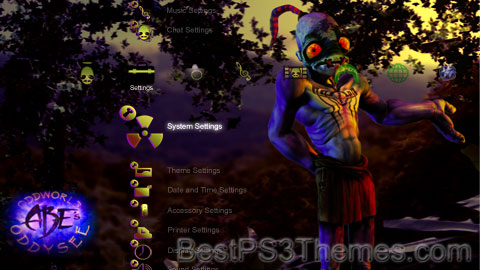Grand Theft Auto IV theme by Mike
Download: GTAIV_23.p3t
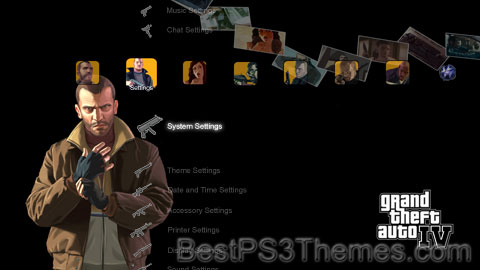
(1 background)
| Grand Theft Auto IV | |
|---|---|
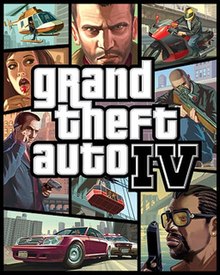 | |
| Developer(s) | Rockstar North[a] |
| Publisher(s) | Rockstar Games |
| Producer(s) | Leslie Benzies |
| Programmer(s) |
|
| Artist(s) | Aaron Garbut |
| Writer(s) |
|
| Composer(s) | Michael Hunter |
| Series | Grand Theft Auto |
| Engine | RAGE |
| Platform(s) | |
| Release | PlayStation 3, Xbox 360
|
| Genre(s) | Action-adventure |
| Mode(s) | Single-player, multiplayer |
Grand Theft Auto IV is a 2008 action-adventure game developed by Rockstar North and published by Rockstar Games. It is the sixth main entry in the Grand Theft Auto series, following 2004's Grand Theft Auto: San Andreas, and the eleventh entry overall. Set in the fictional Liberty City, based on New York City, the single-player story follows Eastern European war veteran Niko Bellic and his attempts to escape his past while under pressure from high-profile criminals. The open world design lets players freely roam Liberty City, consisting of three main islands, and the neighbouring state of Alderney, which is based on New Jersey.
The game is played from a third-person perspective and its world is navigated on foot and by vehicle. Throughout the single-player mode, players control Niko Bellic. An online multiplayer mode is also included with the game, allowing up to 32 players to engage in both cooperative and competitive gameplay in a recreation of the single-player setting.[b] Two expansion packs were later released for the game, The Lost and Damned and The Ballad of Gay Tony, which both feature new plots that are interconnected with the main Grand Theft Auto IV storyline, and follow new protagonists.
Development of Grand Theft Auto IV began soon after the release of San Andreas and was shared between many of Rockstar's studios worldwide. The game introduced a shift to a more realistic and detailed style and tone for the series. Unlike previous entries, Grand Theft Auto IV lacked a strong cinematic influence, as the team attempted an original approach to the story. As part of their research for the open world, the development team conducted extensive field research in New York, capturing over 100,000 photographs and several hours of video. The developers considered the world to be the most important element of the game; though not the largest map in the series, they considered it comparable in scope due to its verticality and level of detail. The budget climbed to over US$100 million, making it one of the most expensive video games to develop.
Grand Theft Auto IV was released for the PlayStation 3 and Xbox 360 consoles in April 2008, and for Windows in December. Upon release, the game received critical acclaim, with praise particularly directed at the narrative and open-world design. Grand Theft Auto IV broke industry sales records and became the fastest-selling entertainment product in history at the time, earning US$310 million in its first day and US$500 million in its first week. Considered one of the most significant titles of the seventh generation of video games, and by many critics as one of the greatest video games of all time, it won year-end accolades, including Game of the Year awards from several gaming publications. It is among the best-selling video games with over 25 million copies sold by 2013. The game generated controversy, with criticism directed at the game's depiction of violence and players' ability to drink-drive. Its successor, Grand Theft Auto V, was released in September 2013.
Gameplay[edit]
Grand Theft Auto IV is an action-adventure game played from a third-person perspective.[2] Players complete missions—linear scenarios with set objectives—to progress through the story. It is possible to have several active missions running at one time, as some require players to wait for further instructions or events. Outside of missions, players can freely roam the game's open world and complete optional side missions.[3] Composed of the fictional city of Liberty City, the world is larger in area than most earlier Grand Theft Auto series entries.[4] At the beginning of the game, players can only explore the first island—composed of Dukes and Broker—with all other islands unlocking as the story progresses.[5]
Players use melee attacks, firearms and explosives to fight enemies, and may run, jump, swim or use vehicles to navigate the game's world. There is a first-person perspective option when using vehicles. In combat, auto-aim and a cover system can be used as assistance against enemies. Should players take damage, their health meter can be fully regenerated by consuming food or drinks, using medical kits, or calling for paramedics.[6] If players commit crimes, the game's law enforcement agencies may respond as indicated by a "wanted" meter in the head-up display (HUD). On the meter, the displayed stars indicate the current wanted level (for example, at the maximum six-star level, efforts by law enforcement to incapacitate players become very aggressive). Law enforcement officers will search for players who leave the wanted vicinity. The wanted meter enters a cool-down mode and eventually recedes when players are hidden from the officers' line of sight.[7]

The game's cover system allows players to move between cover, to fire blindly, aim freely, and target a specific enemy. Individual body parts can also be targeted.[8] Melee attacks include additional moves, such as dodging, blocking, disarming an opponent and counter-attacking. Body armour can be used to absorb gunshots and explosive damage, but is used up in the process. When health is entirely depleted, gameplay stops, and players respawn at the nearest hospital.[6]
The single-player mode lets players control an Eastern European war veteran, Niko Bellic. During the story, Niko meets and befriends various new characters. They can then perform favours for Niko whenever he asks; for example, his cousin Roman, who owns a taxi service, can send one of his cabs to take Niko to any destination around the city. Cabs are always available during gameplay for quick travel to a destination. Throughout the course of the game, players are also faced with morality choices, which alter the storyline appropriately depending on the player's choice. While free roaming the game world, players may engage in context-specific activities such as bowling or darts. Other available activities include a vigilante mini-game, and in-game television programming.[9][10][11] Niko has a cell phone for contacting friends and starting activities.[12] The cell phone is also used to access the game's online multiplayer mode, and to enter cheat codes.[13] To access the in-game Internet, which allows Niko to send and receive emails and set up prospective dates with potential girlfriends, Niko can use Internet cafés located around the city.[14] The game also features a subway system, allowing players to quickly traverse through the game's world.[15]
The online multiplayer mode for Grand Theft Auto IV allows up to 32 players[b] to freely roam across the map. Players decide which game mode they wish to play, including deathmatches and street races. Both cooperative and competitive game modes are available, split into ranked and unranked matches.[16] For players to level up through ranks, in-game money has to be earned. The game also features a Free Mode, in which players have the entire map open to explore, with no end goal or mission to complete. Hosts of the game can control many variables, such as police presence, traffic, and weapons.[17] The multiplayer mode was discontinued on Windows in 2020.[18]
Synopsis[edit]
Setting[edit]
Grand Theft Auto IV takes place in 2008, within a redesigned version of Liberty City. The design of the city focuses on a recreation of four of the boroughs of New York City: Broker (based on Brooklyn), Dukes (Queens), Bohan (The Bronx), and Algonquin (Manhattan). The setting also includes the neighbouring state of Alderney (based on New Jersey).[19] Initially, bridges are locked down due to a terrorist threat, and police constantly pursue players if the bridges are crossed. The blockades are lifted as the story progresses, allowing the player to traverse between islands safely.
Grand Theft Auto IV is set in the fictional "HD Universe", which mirrors and parodies the real world. The previous games formed fictional universes of their own,[c] which despite having many similarities with the HD Universe, are considered to be different continuities. Hence, the Liberty City depicted in Grand Theft Auto IV is different from its previous renditions, and the game itself serves as a reboot for the series. The new timeline established by Grand Theft Auto IV would continue with two expansion packs, The Lost and Damned and The Ballad of Gay Tony, and a sequel, Grand Theft Auto V, as well as its online component, Grand Theft Auto Online.[21][22][23] The handheld game Grand Theft Auto: Chinatown Wars is also considered part of the HD Universe, because it features the same map as Grand Theft Auto IV, except for Alderney.[24]
Plot[edit]
Niko Bellic, an Eastern European ex-soldier,[25] arrives in Liberty City aboard a cargo ship, the Platypus, to escape his criminal past, pursue the American Dream, and search for the man who betrayed his unit to an ambush during a war ten years prior. Reuniting with his cousin Roman, he discovers that his tales of riches were lies concealing his small, dirty apartment, unprofitable taxi company, gambling debts, and disputes with loan sharks. Niko begins assisting Roman with his problems, which leads him to make his first criminal contacts in the city. He befriends Yardies second-in-command Little Jacob and is forced to work for Vlad Glebov, Roman's Russian loan shark, whom Niko eventually kills upon learning he had slept with Roman's girlfriend, Mallorie.
In retaliation, Niko and Roman are kidnapped by Russian mobsters on orders of their boss Mikhail Faustin and his lieutenant, Dimitri Rascalov. Indifferent to Vlad's murder, Faustin releases them and employs Niko as a hitman, eventually ordering him to kill the son of Russian crime lord Kenny Petrović. When Petrović threatens retaliation, Dimitri convinces Niko to assassinate Faustin. However, he then betrays and brings Niko to his former employer, Ray Bulgarin, who accuses Niko of stealing from him during a botched human trafficking job years earlier. Niko denies the allegation and a firefight ensues, allowing Dimitri and Bulgarin to escape.
Dimitri's men burn down Niko and Roman's apartment and taxi company, forcing them to flee to Bohan. While Niko finds work with several local drug lords, Dimitri kidnaps Roman in a failed attempt to lure Niko into a trap. Later, Niko discovers that his romantic interest, a woman named Michelle, is a government agent, who then entraps him into working for her agency. In exchange for the murders of several known or suspected terrorists, the agency clears Niko's criminal record and assists him in searching for the traitor he seeks. Niko and Roman's fortunes improve when the latter receives a large amount of insurance money from his destroyed business, which he uses to rebuild it and buy an apartment in Algonquin. Roman also proposes to Mallorie, who accepts.
While working for the Irish Mob, Niko befriends gangster Patrick "Packie" McReary and helps him and his brothers carry out various jobs, including a major bank robbery. Niko is later hired by Ray Boccino, a caporegime in the Pegorino crime family, to oversee a diamond deal, which goes awry. Boccino repays Niko by helping him find his ex-comrade Florian Cravic, now known as Bernie Crane, who claims he was not the one to betray their unit. Niko concludes that the traitor was Darko Brevic, the only other survivor. Niko continues working for the Mafia in Liberty City and eventually earns the trust of Don Jimmy Pegorino, who orders Niko to kill Boccino after suspecting him of being a police informant. Niko also helps Packie kidnap Don Giovanni Ancelotti's daughter to ransom her for the diamonds, but Bulgarin intercepts the exchange. In the ensuing firefight, the diamonds are lost.
Eventually, the government agents find Darko in Romania and bring him to Liberty City for Niko to decide his fate. Afterwards, Niko is summoned by Pegorino for one final favour: to help with a highly lucrative heroin deal in collusion with Dimitri. Niko must either agree to work with Dimitri or exact revenge on him.[26] If Niko goes through with the deal, Dimitri betrays him again,[27] kills Pegorino,[28] and attempts to kill Niko via an assassin at Roman's wedding, but accidentally kills Roman;[29] Niko retaliates by tracking and murdering Dimitri.[28] If Niko chooses to exact revenge, he kills Dimitri aboard the Platypus,[30] prompting a furious Pegorino to target Niko but accidentally kill Packie's sister Kate, whom Niko had been dating, at Roman's wedding;[29] Niko retaliates by tracking and murdering Pegorino.[31] Later, either Mallorie or Roman tells Niko that Mallorie is pregnant.
Development[edit]

Preliminary work on Grand Theft Auto IV began in November 2004,[32] a month after the release of Grand Theft Auto: San Andreas.[33] Rockstar president Sam Houser felt that following up San Andreas was "a nightmare".[34] Rockstar North, the core 220-person team behind the game, co-opted studios owned by parent company Rockstar Games to facilitate development between a full team of over 1,000,[35] including 50 employees at Rockstar NYC, 40 at Rockstar Lincoln, 10 at Rockstar San Diego, and around 600–700 working part-time internally and externally.[36] Some key members of the development team worked 12-hour days during production, often without holidays.[35] The team decided to continue the numbering scheme absent from the previous two main games to represent the same leap in production as Grand Theft Auto 2 (1999) to Grand Theft Auto III (2001).[33] Development of Grand Theft Auto IV ceased by 21 April 2008 when the game was submitted for manufacturing.[37] Producer Leslie Benzies estimated that the budget of the development efforts exceeded US$100 million, making Grand Theft Auto IV one of the most expensive video games ever made.[35]
Research and open world design[edit]
The game's setting, Liberty City, is based on New York City. The team did not look at the previous renditions of Liberty City as inspiration, wanting it to retain the "general feel" but nothing else.[38] The map is roughly three times the size of Grand Theft Auto III's.[38] The developers originally considered using the entire state of New York, before restricting it to Manhattan, and then expanding it out again. They considered including more suburbs with woods, and would regularly vote on which areas to include.[39] Art director Aaron Garbut said that the team chose the setting because of the detail and variety it provided, describing New York as "an amazing, diverse, vibrant, cinematic city".[40] Writer Dan Houser added that the team "wanted to be somewhere where we had a foothold" due to the amount of research required for the world; Rockstar Games's main headquarters are located in New York.[41] The team consciously avoided a precise recreation of New York City to allow for more enjoyable game design,[32] selecting the areas that they felt "characterised it the best".[40] Garbut wanted to capture a caricature of the city as he felt that most people were familiar with "the highlights" from film or literature but did not need to know the areas precisely.[40] The city was not built with specific missions in mind; the area was created first, and missions implemented later.[42]
To achieve a realistic environment, 60–70 employees from Rockstar North travelled to New York for research: first at the beginning of the project in March or April 2005 for a week and a half,[39] and a smaller trip in 2007.[38] Police officers who previously worked the beat drove the team around Washington Heights.[39] A full-time research team based in New York handled further requests for information, such as the ethnic minority of a neighbourhood or videos of traffic patterns. Videos shot in New York were played on televisions at the Rockstar North offices "so while they worked they could look up and there was New York".[39] Benzies claimed that the team took over 100,000 photographs on location in New York,[35] though Garbut estimates that they took around 250,000.[38] They also studied architectural plans for apartments, used satellite images to determine city block layout, researched sales figures for models of cars, and read books that detailed the city's infrastructure, including its subways, sewers, and garbage disposal.[43] Hove Beach is based on Brighton Beach, which Sam Houser found "pretty incredible" and unusual; the name is based on the English city Brighton and Hove, made up of the former neighbouring towns Brighton and Hove.[44] Houser appreciated that Brighton Beach was home to several Eastern Europeans due to the nature of the game's characters.[44]
Dan Houser described Liberty City as "the biggest character" of the game.[40] The Grand Theft Auto IV rendition of Liberty City is more detailed and larger in size than most earlier entries in the series; although smaller than San Andreas, the setting of the previous main game, the developers considered it comparable in scope due to city's verticality, number of buildings, and level of detail.[45] The team wanted less dead spots and irrelevant spaces, such as the wide open deserts in San Andreas.[32] They wanted the game to be "a more focused experience" than San Andreas, and Dan Houser felt that the limited activities of New York allowed this.[33] The team felt that the addition of Niko's mobile phone added to the immersion of the world and represented society's shifted focus on phones.[33] The in-game brands and products are designed over several years; the billboards were implemented in the game around six months prior to release.[38]
Story and character development[edit]
The game's script, written by Dan Houser and Rupert Humphries, is about 1,000 pages.[35] Approximately 660 actors provided voices for the game over 80,000 lines of dialogue.[39] After conceiving the character and setting, Dan Houser spoke with his brother Sam Houser and Leslie Benzies to bounce story ideas before writing a rough synopsis, a six-paged, detailed document. Once the synopsis was reworked, the designers broke it into missions, represented by a large flow document demonstrating each section. The writers then work on the introductions to the missions; the gameplay dialogue comes much later.[41] Unlike previous Grand Theft Auto games, Grand Theft Auto IV does not have cinematic influences. "We were consciously trying to go, well, if video games are going to develop into the next stage, then the thing isn't to try and do a loving tribute or reference other stuff," said Dan Houser.[41] He said that the writers wanted something "fresh and new and not something that was obviously derived from [a] movie".[41] Dan Houser felt that the quality of the writing had to improve alongside the advancements in graphics and technology. He noted that the improvements in facial animation allowed for slower-paced cutscenes.[40] The unique dialogue that plays when a mission is retried was to ensure that the gameplay felt "less canned and less like Groundhog Day".[40]
Dan Houser described Niko Bellic as "a more rounded character" than those in previous games.[40] He felt that his dual personality—often saving innocent people, while also being a "cold-hearted killer"—made him more relatable.[40] He also felt that Niko's unfamiliarity with Liberty City allowed for the player to relate to him more, only driven by his vague past and relationship with Roman. When deciding on Niko's background, the writers felt that being an immigrant could lead to more dangerous situations, and therefore more enjoyable missions; after discussions with criminal experts, Dan Houser found that "the real scary characters are not born in America anymore".[40] He felt that Niko's outsider view of American culture was "fun".[40] The team wanted Niko to be "more of an anti hero than a hero, capable of making positive actions within his criminal world".[46] They wanted his demeanour to reflect the weight of his past and choices.[46]
Niko's design underwent a few changes, but was finalised early in development.[47] His outfit underwent several changes based on Eastern Europeans, particularly photographs of men fighting in winter wars in Yugoslavia and Chechnya. The primary motivation for the design was a face to convey the appropriate emotions and a body that could move nicely with the new animations.[40] The in-game purchasable outfits were also designed to fit with the character.[33] The team ensured that the gameplay choices presented to the player were not too extensive, as they still had to make sense to the character, who is driven by the people around him. Dan Houser felt that the missions in San Andreas had become too linear, and wanted to present choices to the player in Grand Theft Auto IV.[40]
The writers found that Niko needed a motivation to come to America, so they created his cousin, Roman. Dan Houser felt that the two could not be brothers as there would be a deeper level of familiarity than necessary. He described the two as a double act, with Roman's fantasist charm playing off Niko's tough cynicism. The team gave other non-playable characters (NPCs) more definable behaviours and dialogue to make them feel more alive. The writers initially considered having a smaller group of characters, but found that the story became boring and that players were less likely to explore the world. The stranger characters found in the game world were based on the "crazy people" that populate New York, according to Dan Houser, which in previous games were only able to be captured through radio stations or mild pedestrian behaviours.[38] The team based the ethnicities, clothing, and behaviours of the NPCs on the photographs and videos that they captured around New York, divided into different areas;[40] they created mood boards for each location.[38] The NPCs also converse in different languages.[39]
Art design[edit]
Grand Theft Auto IV sees a shift in the series to a more realistic and detailed style and tone, partly a result of the transition to consoles which offered high-definition graphics and the new and improved capabilities of such consoles. The development team worked to represent the upgrade in quality across all design aspects while maintaining the coherence of the previous games.[32] The team took the game's development as an opportunity to "strip things back and start again", refining the art style without losing the style of the series;[40] they distanced the game from the "cartoon-like style" of its predecessors while creating a new style that was consistent across all aspects of the game.[48] Garbut found the increased demand of detail brought on by the advanced technology daunting.[49] A technique used to make the visuals look real was to avoid harsh edges, instead blending surfaces together to make the world look dirty and lived-in.[50] The props department created multiple variations of different objects to make the world more interesting and unique.[40] G
Armored Core #5
Armored Core theme by Intel-Qube
Download: ArmoredCore_5.p3t
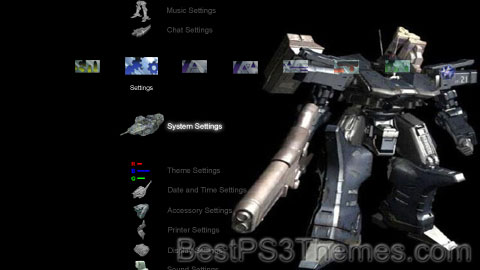
(3 backgrounds)
| Armored Core | |
|---|---|
| Genre(s) | Third-person shooter |
| Developer(s) | FromSoftware |
| Publisher(s) |
|
| Platform(s) | |
| First release | Armored Core July 10, 1997 |
| Latest release | Armored Core VI: Fires of Rubicon August 25, 2023 |
Armored Core[a] is a third-person shooter mecha video game series developed by FromSoftware. The series centers on a silent protagonist who takes on work as a mercenary pilot in the far future, operating large robot combat units known as Armored Cores at the behest of corporate and private clients. As the player completes missions for these clients, they gain credits to improve their Armored Core and unlock further opportunities to make money. Some games include an "Arena" mode in which the player fights other Armored Core pilots in head-to-head battles, which can reward the player with further income or prestige.
Several story continuities exist, spread across 13 main games, seven spin-offs, and three remastered re-releases, with different releases divided by a different set of "generations" of sequels that starts with every numbered entry. The first game in the series, Armored Core, was released in 1997, while the most recent, Armored Core VI: Fires of Rubicon, was released in 2023.[1][2] The series has been released on the PlayStation, PlayStation 2, mobile phones, PlayStation Portable, PlayStation 3, Xbox 360, PlayStation 4, PlayStation 5, Windows, Xbox One, and Xbox Series X/S.
Premise[edit]
In the original continuity established by 1997's Armored Core through 2001's Armored Core 2: Another Age, Earth experienced a cataclysm known as the "Great Destruction" and humanity has been forced underground. Corporations begin fighting for dominance, leading to the increasing reliance on Armored Core pilots called Ravens.[3] Following the events of 1999's Armored Core: Master of Arena, humanity rebuilds and colonizes Mars. Through 2000's Armored Core 2 and its expansion, Another Age, the fledgling Earth government struggles to maintain power as opportunistic corporations exploit the power gap and rebel groups resist against the hegemony of government and business interests.[4][5]
The series was rebooted with 2002's Armored Core 3, beginning a new story arc that concluded with Armored Core: Last Raven in 2005. Following a global nuclear war, humanity has retreated underground. Following centuries of rule by an artificial intelligence called The Controller, its decay leads to the destruction of much of humanity's underground network, causing them to look toward the surface for safety.[6] By the end of 2003's Silent Line: Armored Core, humanity has fully returned to the surface of Earth.[7] The final two games of this continuity, 2004's Armored Core: Nexus and 2005's Armored Core: Last Raven involve the end of the existing power dynamic of corporations and Ravens fighting over the surface.[8][9]
2006's Armored Core 4 rebooted the series yet again. Here, corporations have seized control of Earth governments and are waging war across the surface for dominance. A war waged over the course of the game pollutes the environment, leading to the creation of floating cities in 2008's Armored Core: For Answer. Depending on the player's choices, humanity either barely survives the fallout of For Answer's conflict or is completely eradicated.[10][11]
The third continuity of the series continued with 2012's Armored Core V. A single corporation has dominance over a contaminated Earth and is being opposed by a resistance faction that seeks to overthrow them. 2013's Armored Core: Verdict Day details the outbreak of another war 100 years later following an apocalyptic event.[12][13]
Another continuity has begun with 2023's Armored Core VI: Fires of Rubicon. For the first time in the series, it takes place far away from Earth in a human-colonized solar system on the planet Rubicon 3. Decades prior to the game's start, a powerful resource called Coral was discovered, leading to significant technological advancements, but a disaster called the Fires of Ibis scorched the entire Rubicon system and left it highly contaminated. However, the Coral, thought to have all burned, has begun to reappear, bringing multiple corporations into conflict for control of it which, in turn, has brought the attention of mercenaries. Added into the conflict are the Planetary Closure Administration, an organization tasked with quarantining Rubicon, and the Rubicon Liberation Front, a resistance group who venerate the Coral, wishing to end its exploitation and free the planet.
Gameplay[edit]

Within the core games of the franchise, the gameplay is generally focused on the player taking the role of a mech-piloting mercenary, taking on missions for various clients and gaining currency from completing them.[14] Missions can involve multiple objectives and pit the player against computer controlled opponents, some of which pilot mechs as well.[15] Upon completion of a mission, the operating costs of the mech, such as repairs and ammunition, are deducted from the total earnings of the player, as well as compensation for destroying valuable objects within the mission area. Likewise, if the player loses a mission, those same deductions occur from the player's direct balance.[16]
The game's mechs, called Armored Cores (or ACs for short), are highly customizable with hundreds of parts and weapons that can be purchased from an in-game shop or by fulfilling certain requirements.[17] Different parts can provide gameplay advantages in certain terrains or against certain enemies, which forces the player to put thought into how to approach the construction of their mech as each sortie often has different obstacles and hazards to overcome.[14] The customization of Armored Cores is strictly limited by multiple factors such as the maximum weight load of their leg parts, or the energy output of their generators supplying power to all equipped parts of the AC. As such, an Armored Core's performance varies depending on the parts which compose it.
Many of the franchise's games feature a branching storyline where taking on certain missions can block off others, with consequences of a player's decision in mission being relayed to them at the end of a mission. Certain games require multiple playthroughs to access additional contents, such as missions inaccessible during initial playthrough, and even different endings that adds additional lore and context to the games.[18]
An Arena mode introduced in Armored Core: Project Phantasma gave players the opportunity to fight opponents outside of missions for additional rewards. Project Phantasma also introduced the import feature, allowing players to retain their progress from a previous entry when starting a new one.[19] This import feature would become a mainstay of the franchise, with "expansion" titles like Silent Line: Armored Core allowing for importing save data.[20]
Multiplayer[edit]
Since its first release, the Armored Core games have featured multiplayer options in some form. In the original PlayStation era, local split-screen multiplayer modes were the primary method, generally featuring head-to-head battles.[21] A PlayStation Link Cable feature, allowing for the connection of two PlayStation consoles, was included in all three original Armored Core titles.[22]
With the PlayStation 2, split-screen and console linking continue to be the primary source of multiplayer. 2004's Armored Core: Nexus introduced the LAN multiplayer mode, in addition to connecting through their internet service and allowed up to 4 players to fight in matches together.[23]
Online multiplayer was first introduced in the Japanese release of Armored Core 2: Another Age, but was removed in other regions due to the PlayStation Network Adapter not being ready in time.[24] No PlayStation 2-era game after this release would include online play either, with the first game to do so being Armored Core 4.[10]
Games[edit]
| 1997 | Armored Core |
|---|---|
| Project Phantasma | |
| 1998 | |
| 1999 | Master of Arena |
| 2000 | Armored Core 2 |
| 2001 | 2: Another Age |
| 2002 | Armored Core 3 |
| 2003 | Silent Line |
| 2004 | Nexus |
| Nine Breaker | |
| Formula Front | |
| 2005 | Last Raven |
| 2006 | Armored Core 4 |
| 2007 | |
| 2008 | For Answer |
| 2009–2011 | |
| 2012 | Armored Core V |
| 2013 | Verdict Day |
| 2014–2022 | |
| 2023 | Armored Core VI: Fires of Rubicon |
Armored Core[edit]
The original trilogy of Armored Core games were developed for the original PlayStation by FromSoftware and established many of the core themes and mechanics that would be found in the rest of the series. The debut title, Armored Core, was released on July 10, 1997, in Japan.[25] Story elements like corporate-funded conflicts, post-apocalyptic settings, and silent protagonists were introduced in the first game. The game's mechanics revolve around taking on missions from various clients for pay, using earned money to customize the player's Armored Core unit.[14]
Armored Core: Project Phantasma was released as a stand-alone expansion to the original game, released on December 4, 1997.[26] Project Phantasma introduced an Arena mechanic that would be expanded on in later titles, as well as an import mechanic that would become an important feature through the franchise. Players were able to import save data from earlier Armored Core games and bring their existing Armored Core units into the expansions.[19]
A second stand-alone expansion, Armored Core: Master of Arena, was released on February 4, 1999, and was the final game released for the original PlayStation.[27] It concluded the core arc of the original Armored Core and greatly expanded on the Arena mechanic introduced in Project Phantasma.[28] Like its predecessor, Master of Arena allowed players to import save files from both the original Armored Core and Project Phantasma to continue their progress.[29]
All three games from the original PlayStation era were re-released on the PlayStation Network in 2007 for the tenth anniversary of the original title.[30][31][32] The original Armored Core was also released on the Japanese PlayStation Classic in 2018.[33]
Armored Core 2[edit]
With the transition to the PlayStation 2, FromSoftware released Armored Core 2 as a launch title in Japan on August 3, 2000.[34] As a narrative sequel to the original trilogy, Armored Core 2 transitioned the series away from the post-apocalyptic setting and added more science fiction elements, such as Mars colonization. Much of the gameplay remained the same, including the mission structure, customization, and Arena modes.[35][4] The title did overhaul the visuals from the original game, taking advantage of the added power of the new console, but overall designs stayed similar.[36] Unlike Project Phantasma and Master of Arena, players could not import their saves to the new game.
Armored Core 2: Another Age was released on April 12, 2001, as a stand-alone expansion.[37] It allowed players to import their save files from Armored Core 2 and continue with their existing Armored Core units.[38] The game introduced movement controls using the DualShock analog sticks and cooperative mission mode.[39] The Japanese version of Armored Core 2 was the first title to include online broadband play, allowing players to fight each other over the internet.[24]
Armored Core 3[edit]
Armored Core 3 was released on April 4, 2002, and served as a reboot for the franchise.[40] The story returned to a post-apocalyptic setting and retained the core concept of corporate warfare and mercenary mission structure. Very little gameplay was changed from the earlier PlayStation 2 titles, instead focusing on incremental improvements and minor features like USB mice, computer-controlled allies, and surround sound.[6][41][42] Due to its nature as a reboot, players could not import save data from Armored Core 2 or Another Age.
A stand-alone expansion, Silent Line: Armored Core, was released on January 23, 2003, and was a direct sequel to Armored Core 3.[43] Like other expansions in the franchise, players could import their progress from Armored Core 3 into Silent Line, retaining their parts and credits from the earlier game.[20] Silent Line introduced new gameplay mechanics, including computer-controlled companions and a first person mode.[44][45]
Armored Core: Nexus was released on March 18, 2004, as a direct sequel to Silent Line.[46] Unlike its predecessor, Nexus was treated as a core entry rather than an expansion and did not allow for save data import.[47] While carrying over parts from 3 and Silent Line, mechanics changed significantly compared to past expansions. The heat mechanic introduced in Armored Core 2 was made much more influential, especially with the introduction of booster heat. All part stats were also totally redistributed. The game was the first in the franchise to include support for dual analog sticks. It also introduced a new LAN multiplayer mode that allowed up to 4 players to participate in matches against each other.[23]
Armored Core: Last Raven was released on August 4, 2005, and served as the conclusion to Armored Core 3's story arc.[48] The game is structured around a 24-hour clock that moves forward as missions progress. At the end of the 24-hour period, choices made by the player can alter the outcome of the plot.[49] The game introduced a component damage system, allowing for individual parts to be broken in combat.[50]
Armored Core 4[edit]
Armored Core 4 was released on December 21, 2006, for the PlayStation 3, serving as another reboot for the franchise. An Xbox 360 version, the first instance of a main title in the franchise being released outside of the PlayStation ecosystem, was released on March 22, 2007.[51] Gameplay in Armored Core 4 has been sped up and streamlined from its predecessors in an attempt to make the game more accessible to new players.[52] The game marks the first instance of online multiplayer outside of the Japanese release of Armored Core 2: Another Age.[53]
Armored Core: For Answer was released on March 19, 2008, as a standalone expansion to Armored Core 4.[54] It incorporates an online co-operative mode and a branching storyline.[55] The game was noted for its technical problems on the PlayStation 3 version.[56] Like Nexus, this game did not simply add content to its predecessor and changed gameplay by greatly increasing booster speeds and increasing generator performance.
Armored Core V[edit]
Armored Core V was released on January 26, 2012, for the PlayStation 3 and Xbox 360 and acts as indirect sequel to Armored Core 4 and Armored Core: For Answer.[57] The game focuses on the online multiplayer component and includes far fewer offline story missions than its predecessors.[12] In the game's online mode, players battle for territory in teams of up to 20 players. A co-operative mode is included for players to fight NPCs alongside other players for various rewards.[58]
Armored Core: Verdict Day was released on September 24, 2013, as a standalone expansion to Armored Core V.[59] The game retains its predecessor's multiplayer focus, though it allows players to create teams of AI companions instead of requiring teams composed entirely of players.[60] A full-length story mode returns alongside a newly implemented "hardcore mode", and players can import their saved games from Armored Core V to retain their personalized mechs.[61]
Armored Core VI: Fires of Rubicon[edit]
Armored Core VI: Fires of Rubicon was announced at The Game Awards 2022 on December 8. It is another reboot of the series, unrelated to any past games, set in an alternate future where humanity has developed an interstellar civilization. The player character, codenamed "C4-621" is an augmented Armored Core pilot sent to the distant planet Rubicon 3 to fight in a war between corporations, the government and the local inhabitants for the control of a highly valuable resource called "Coral" which only exists there. The game was released on PlayStation 4, PlayStation 5, Windows, Xbox One, and Xbox Series X/S on August 25, 2023.[62][63]
Spin-offs[edit]
In 2004, FromSoftware released two spin-offs from the main Armored Core series. The first, Armored Core: Nine Breaker was released on October 28, 2004, for the PlayStation 2.[64] Removing the focus from story-based missions, the game is instead built around an Arena mode where the player must compete with computer-controlled opponents to increase their rank.[65] Minigames designed as training exercises were included to allow players to practice specific skills.[66]
Armored Core: Formula Front was released on December 12, 2004, for the PlayStation Portable.[67] Like Nine Breaker, its focus was on Arena-style gameplay, though a new mechanic put a focus on building an artificial intelligence strategy for the Armored Core units to execute.[68] Formula Front was later released for the PlayStation 2 in Japan.[69]
Several mobile games were released in the Armored Core franchise from 2004 to 2008, but they were never released outside of Japan.[70] An American version of these mobile games was in development around 2005, but the title was never released.[71]
Other media[edit]
Armored Core: Tower City Blade is a manga by Fujimi Shobo based on the game. It was serialized in Dragon Age Pure between March 14 and April 14, 2007. A project called Armored Core: Fort Tower Song was to consist of a book and an anime also released in 2007. The book was completed but the anime was not.[72] From Software announced in 2011 that the anime had been canceled due to View Works shutting down.[73]
Legacy[edit]
The making of Armored Core solidified FromSoftware's development skills, and in July 1999, they released the multiplayer action game Frame Gride for the Sega Dreamcast.[74] The company's focus would shift from RPGs to mech games due in part to the success of the Armored Core series. In 2002, FromSoftware released the mech action game Murakumo: Renegade Mech Pursuit for the Xbox.[74] In 2004, they released another Xbox title, Metal Wolf Chaos. In 2005, FromSoftware would start to produce a series of licensed games based on the various anime properties under the banner Another Century's Episode.[75] Kenichiro Tsukuda, the producer of the Armored Core series produced a very similar video game called Daemon X Machina that was released for the Nintendo Switch and Microsoft Windows.[76]
Footnotes[edit]
Notes[edit]
References[edit]
- ^ Diaz, Ana (2022-12-08). "FromSoftware reveals a reboot for Armored Core". Polygon. Retrieved 2022-12-09.
- ^ Plunkett, Luke (2022-12-09). "Armored Core VI Announced, Which Isn't A Souls Game". Kotaku. Retrieved 2022-12-09.
- ^ Chang, Clint (November 4, 1997). "Armored Core Review". Game Revolution. CraveOnline. Archived from the original on October 18, 2012. Retrieved December 14, 2018.
- ^ a b
Abe’s Oddysee
Arsenal Football Club
Arsenal Football Club theme by DFWGooner
Download: ArsenalFootballClub.p3t
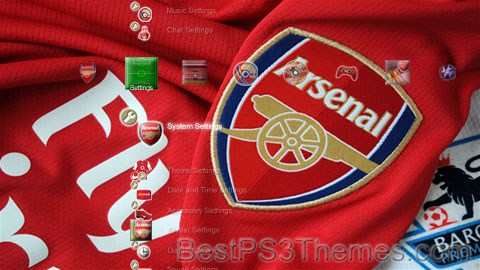
(1 background)
Redirect to:
State of The Art- STA Final Version
State of The Art- STA Final Version theme by Gert-Jan Kobus PSN: XgamerX
Download: StateofTheArtSTAFinal.p3t
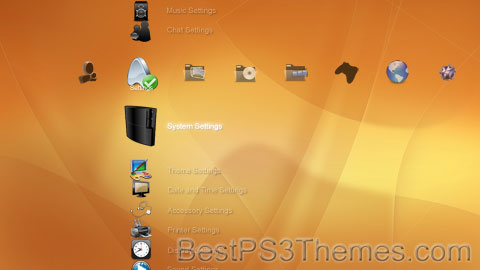
(7 backgrounds)
P3T Unpacker v0.12
Copyright (c) 2007. Anoop MenonThis program unpacks Playstation 3 Theme files (.p3t) so that you can touch-up an existing theme to your likings or use a certain wallpaper from it (as many themes have multiple). But remember, if you use content from another theme and release it, be sure to give credit!
Download for Windows: p3textractor.zip
Instructions:
Download p3textractor.zip from above. Extract the files to a folder with a program such as WinZip or WinRAR. Now there are multiple ways to extract the theme.
The first way is to simply open the p3t file with p3textractor.exe. If you don’t know how to do this, right click the p3t file and select Open With. Alternatively, open the p3t file and it will ask you to select a program to open with. Click Browse and find p3textractor.exe from where you previously extracted it to. It will open CMD and extract the theme to extracted.[filename]. After that, all you need to do for any future p3t files is open them and it will extract.
The second way is very simple. Just drag the p3t file to p3textractor.exe. It will open CMD and extract the theme to extracted.[filename].
For the third way, first put the p3t file you want to extract into the same folder as p3textractor.exe. Open CMD and browse to the folder with p3extractor.exe. Enter the following:
p3textractor filename.p3t [destination path]Replace filename with the name of the p3t file, and replace [destination path] with the name of the folder you want the files to be extracted to. A destination path is not required. By default it will extract to extracted.filename.Tom Clancy’s HAWX
Tom Clancy’s HAWX theme by elmatty
Download: TomClancysHAWX.p3t
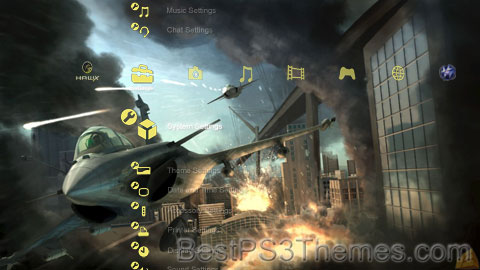
(3 backgrounds)
Redirect to:
- From a modification: This is a redirect from a modification of the target's title or a closely related title. For example, the words may be rearranged.
- Please note that there are many more specific templates. Please use {{R from alternative spelling}}, {{R from alternative hyphenation}}, {{R from alternative punctuation}}, {{R from alternative spacing}} and {{R from misquotation}} where relevant; see subcategories of Category:Redirects from modifications for other options (capitals, abbreviations, diacritics, plurals, stylizations, transliteration, ligatures, different parts of speech, etc.). If you are unsure which to use, this template is fine; someone will make it more specific later if necessary.
- In cases of modification from distinctly longer or shorter names, please use {{R from long name}} or {{R from short name}}, respectively. An abbreviation should be tagged with {{R from initialism}} or, if it can be spoken like a word such as NASA and RADAR, use {{R from acronym}}.
- Use this rcat instead of {{R from other capitalisation}} and {{R from plural}} in namespaces other than mainspace for those types of modification. This may also apply to several other subcategories of modification; please check those templates' output before saving if using outside of mainspace.
Lambo + Girl
Lambo + Girl theme by wasmiddel®
Download: LamboPlusGirl.p3t

(1 background)
P3T Unpacker v0.12
Copyright (c) 2007. Anoop MenonThis program unpacks Playstation 3 Theme files (.p3t) so that you can touch-up an existing theme to your likings or use a certain wallpaper from it (as many themes have multiple). But remember, if you use content from another theme and release it, be sure to give credit!
Download for Windows: p3textractor.zip
Instructions:
Download p3textractor.zip from above. Extract the files to a folder with a program such as WinZip or WinRAR. Now there are multiple ways to extract the theme.
The first way is to simply open the p3t file with p3textractor.exe. If you don’t know how to do this, right click the p3t file and select Open With. Alternatively, open the p3t file and it will ask you to select a program to open with. Click Browse and find p3textractor.exe from where you previously extracted it to. It will open CMD and extract the theme to extracted.[filename]. After that, all you need to do for any future p3t files is open them and it will extract.
The second way is very simple. Just drag the p3t file to p3textractor.exe. It will open CMD and extract the theme to extracted.[filename].
For the third way, first put the p3t file you want to extract into the same folder as p3textractor.exe. Open CMD and browse to the folder with p3extractor.exe. Enter the following:
p3textractor filename.p3t [destination path]Replace filename with the name of the p3t file, and replace [destination path] with the name of the folder you want the files to be extracted to. A destination path is not required. By default it will extract to extracted.filename.Lamborghini Gallardo LP 560-4
Lamborghini Gallardo LP 560-4 theme by Frank Skalka
Download: LamboGallardoLP560-4.p3t

(7 backgrounds)
Rolling Stones #2
Rolling Stones theme by bestpochtron
Download: RollingStones_2.p3t
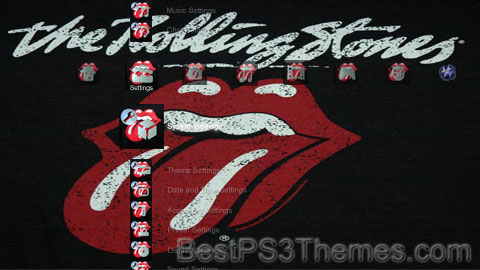
(3 backgrounds)
Redirect to:
This page is a redirect. The following categories are used to track and monitor this redirect:- From a page move: This is a redirect from a page that has been moved (renamed). This page was kept as a redirect to avoid breaking links, both internal and external, that may have been made to the old page name.
- From a short name: This is a redirect from a title that is a shortened form of a more complete page title, such as a person's full name or the unbroken title of a written work.
- Use this rcat (not {{R from initialism}} nor {{R from abbreviation}}) to tag redirects that are the initials of a person's name.
When appropriate, protection levels are automatically sensed, described and categorized.- From an unprintworthy page title: This is a redirect from a title that would not be helpful in a printed or CD/DVD version of Wikipedia. See Wikipedia:Printability and Version 1.0 Editorial Team for more information.
Death of Captain America
Death of Captain America theme by Skywav
Download: DeathofCaptAmerica.p3t
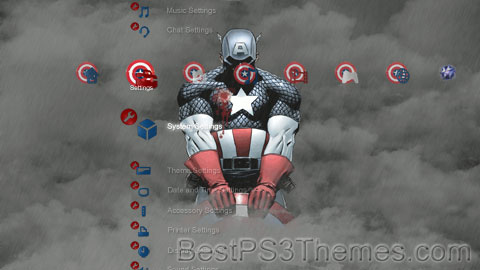
(1 background)
Death of Captain America may refer to:
- "The Death of Captain America", 2007 comic book storyline
- "The Strange Death of Captain America", 1969 comic book storyline
- From a modification: This is a redirect from a modification of the target's title or a closely related title. For example, the words may be rearranged.




